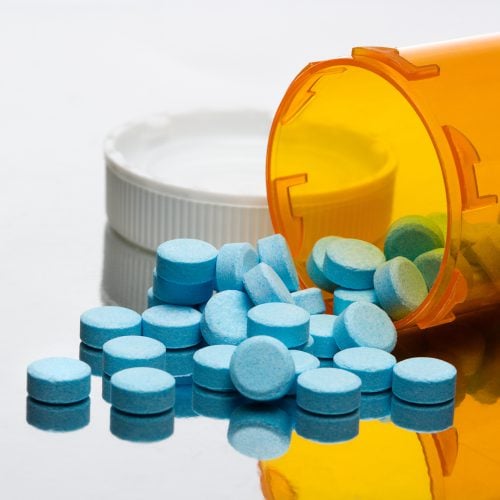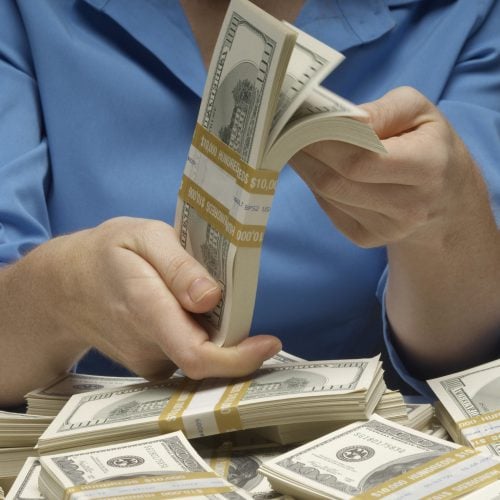
Attaining a certain drug can mean the difference between life and death for millions of Americans. These essential products also help generate billions for drug manufacturers.
Pharmaceutical companies generate an estimated $300 billion in profit a year, according to the World Health Organization (WHO). Much of that value is driven by a handful of extremely popular prescription drugs. 24/7 Wall St. reviewed the 15 top annual sales figures for prescription medications from IMS Health, a company that tracks the drugs bought by hospitals and pharmacies.
Most of the best-selling drugs are made by the world’s largest pharmaceutical companies, which dominate the industry. The world’s 10 largest pharmaceutical companies are responsible for 11 of the 15 best-selling drugs in the world. Annual sales of these 15 drugs account for 12% of all prescription drug sales globally. Swiss drug maker Roche developed and markets three of the world’s 15 best-selling medications, British pharmaceutical company AstraZeneca sells two. The two companies sold a combined $34.3 billion of the five drugs in 2014 alone.
Click here to see the world’s 15 top selling drugs.
A wide range of factors ultimately determine whether or not a drug becomes a blockbuster, selling at least $1 billion a year. Perhaps the most important factor, aside from providing effective treatment, is the prevalence of the condition the drug treats. For example, in the United States — by far the world’s largest consumer of prescription drugs — diabetes and arthritis are among the most common treatable diseases. Partially as a result, six of the 15 prescription drugs bringing in billions in annual sales treat some form of diabetes or arthritis.
Widespread usage is only one half of the equation. The other half is price. The most expensive drug in the United States is Sovaldi, a drug that can cure hepatitis C, a condition that infects less than 30,000 Americans a year. A 12 week supply of the medication costs $81,000. Due in part to the high cost, Sovaldi brought its manufacturer, Gilead Sciences, $9.4 billion in sales in 2014 alone, more than all but two other prescription drugs.
In addition to demand and cost, market share can also greatly influence a drug’s sales. Once a drug is developed it has to be approved by the U.S. Food and Drug Administration (FDA), which often also grants the developer exclusive sales rights for a set period of time, from 180 days to seven years. The exclusivity protects the developer from competition and is intended to incentivize innovation. High sales of many of the best selling drugs are often attributable to exclusivity provisions. Exclusivity and patent laws vary by country.
When exclusivity protections expire, other companies can introduce identical drugs known as generics. Generics are typically far cheaper than the original brand name drug and save consumers up to $10 billion a year through pharmacy sales alone. Hospitals also save billions when generic drugs are released. Name brand drug manufacturers will often pay would-be generic drug makers to keep their product off the market for a certain amount of time in an attempt to sustain market share.
To identify the best-selling drugs in the world, 24/7 Wall St. reviewed global 2014 sales of prescription drugs from health industry research firm IMS Health. Global sales are in U.S. dollars. We only considered medications available in the United States. Sales figures cover wholesale and manufacturer channels.
These are the 15 best selling drugs in the world.
15. Copaxone
> 2014 sales: $4.8 billion
> Treatment for: Multiple sclerosis
> Drug manufacturer: Teva Pharmaceutical Industries (NYSE: TEVA)
> Company’s headquarter: Israel
Multiple sclerosis (MS) is a disease that disrupts the transmission of nerve signals from the brain to the rest of the body, leading to a host of potentially debilitating symptoms. Though the disease is relatively rare, Teva Pharmaceutical Industries sold $4.8 billion of its multiple sclerosis drug Copaxone in 2014, up slightly from $4.7 billion the previous year. Competition from generic versions of drugs is inevitable. However, despite the release last year of a generic version of Copaxone from competing pharmaceutical company Novartis, sales of Copaxone remain high.
14. Januvia
> 2014 sales: $5.0 billion
> Treatment for: Diabetes
> Drug manufacturer: Merck & Co. Inc. (NYSE: MRK)
> Company’s headquarter: United States
Diabetes is one of the most common diseases in the United States, afflicting approximately 9.3% of the population, and several treatments of the condition are big sellers. Pharmaceutical giant Merck reported $5 billion in sales of its diabetes drug Januvia in 2014. Like many drugs, however, Januvia has some unforeseen negative side effects. In 2015, the FDA added a warning to the drug that it may cause severe to disabling joint pain. From its introduction in 2006 through 2013, Januvia was linked to 28 cases of debilitating joint pain.
13. Spiriva
> 2014 sales: $5.5 billion
> Treatment for: Chronic obstructive pulmonary disease (COPD)
> Drug manufacturer: The Boehringer Ingelheim Group
> Company’s headquarter: Germany
COPD is a blanket term for a number of respiratory problems, including emphysema, chronic bronchitis, and some forms of asthma, that affect more than 24 million people in the United States alone, according to the COPD Foundation. Spiriva, the most popular medication used to treat COPD, racked up $5.5 billion in global sales in 2014. The drug is marketed and sold by international pharmaceutical company Boehringer Ingelheim, a German drug maker that focuses on respiratory conditions.
12. Herceptin
> 2014 sales: $5.6 billion
> Treatment for: Various cancers
> Drug manufacturer: The Roche Group
> Company’s headquarter: Switzerland
Used to treat a variety of cancers, Herceptin is among the best selling drugs in the world. The drug was one of three by pharmaceutical giant Roche to post at least $5.6 billion in sales in 2014. Like many other popular prescription drugs, Herceptin is not without some potentially serious adverse side effects. A recently published study in the Journal of Clinical Oncology found that Herceptin, while known to increase the risk of congestive heart failure in elderly patients, may also cause heart problems in patients of all ages.
11. Lyrica
> 2014 sales: $6.0 billion
> Treatment for: Nerve disorders
> Drug manufacturer: Pfizer Inc. (NYSE: PFE)
> Company’s headquarter: United States
Since its introduction in 2006, more than 9 million Americans have used Lyrica to treat pain from a range of diseases, including diabetes, shingles, and fibromyalgia. Invented in a lab at Northwestern University, the compound pregabalin is now sold and marketed as Lyrica by pharmaceutical giant Pfizer in an agreement with the university. Sales of the drug hit $6 billion in 2014, up 19% from the year before. Over the years, Northwestern has added $1.4 billion to its endowment from Lyrica sales. While the company’s patent on the drug has already expired in some European countries, Pfizer has exclusive rights in the United States until 2018.
10. Avastin
> 2014 sales: $6.1 billion
> Treatment for: Various cancers
> Drug manufacturer: The Roche Group
> Company’s headquarter: Switzerland
Approximately half of all cancer drug are sold by Roche, Novartis, and Amgen. Roche, the largest of the three, is the company behind three of the world’s best selling cancer drugs. Sales of Avastin, a drug meant to treat several cancers — cervical, colon, kidney, ovarian, lung, and brain — increased 6.4% from 2013 to 2014 to $6.1 billion. The drug is one of less than a dozen prescription medications with 2014 sales of more than $6 billion.
9. Rituxan/Mabthera
> 2014 sales: $6.6 billion
> Treatment for: Various cancers
> Drug manufacturer: The Roche Group
> Company’s headquarter: Switzerland
Marketed as Rituxan in the United States, Mabthera is a drug intended to treat certain forms of non-Hodgkin lymphoma and chronic lymphocytic leukaemia. The drug, made by Roche’s Genentech, has also been shown to be effective as a treatment for rheumatoid arthritis. Roche is the world’s largest producer of cancer drugs — and Rituxan is its best seller.
8. Nexium
> 2014 sales: $7.7 billion
> Treatment for: Acid reflux
> Drug manufacturer: AstraZeneca (NYSE: AZN)
> Company’s headquarter: United Kingdom
Used to treat symptoms of acid reflux disease like heartburn, Nexium is one of the best selling prescription drugs in the world. A recent study suggested that Nexium and other similar drugs may lead to an increased risk of kidney disease. If consumers believe this risk outweighs the drug’s benefits, Nexium sales may soon fade. The drug’s $7.7 billion in 2014 sales marked a 1.4% drop from $7.9 billion the year before. It is the only drug on this list that posted a one-year sales decline.
7. Remicade
> 2014 sales: $8.1 billion
> Treatment for: Arthritis, psoriasis, bowel diseases
> Drug manufacturer: Johnson & Johnson (NYSE: JNJ)
> Company’s headquarter: United States
More than 2 million people worldwide have used Remicade to treat a range of conditions, including bowel diseases Crohn’s and ulcerative colitis, as well as the severe skin condition plaque psoriasis. Johnson & Johnson sold $8.1 billion worth of the drug in 2014, up 7.7% from $7.6 billion the year before. The pharmaceutical giant holds several patents on compounds contained in its best-selling drug, Remicade — some extending as far as 2027. According to the company, this means it is unlikely that a viable alternative to Remicade will hit the U.S. market in the near future.
6. Crestor
> 2014 sales: $8.5 billion
> Treatment for: High cholesterol
> Drug manufacturer: AstraZeneca
> Company’s headquarter: United Kingdom
Crestor is British drug manufacturer AstraZeneca’s best-selling drug. It is also the best-selling prescription treatment for high cholesterol. The company is expecting Crestor sales to take a hit in the near future, however, as its patent is set to expire in 2016, opening the door for other drug companies to release generic versions of the formula and cash in on the blockbuster drug.
5. Enbrel
> 2014 sales: $8.7 billion
> Treatment for: Arthritis, psoriasis
> Drug manufacturer: Amgen Inc. (NYSE: AZN)
> Company’s headquarter: United States
Rheumatoid arthritis, a condition causing inflammation of the joints, and plaque psoriasis,a severe skin condition, are fairly common. Together, the two conditions affect approximately 2.8 million adults nationwide. Enbrel, a drug that treats both conditions, is one of the best selling drugs in the world. Amgen, the company behind the medication, is currently suing drug manufacturer Novartis, claiming the rival company manufactured a copycat drug, unfairly piggybacking on the decades of development that went into Enbrel. The drug is also licensed to Pfizer, which markets the drug outside the United States.
4. Abilify
> 2014 sales: $9.3 billion
> Treatment for: Serious mental illness
> Drug manufacturer: Otsuka Group
> Company’s headquarter: Japan
Abilify is an antipsychotic that treats patients with severe depression as well as other mental illnesses such as schizophrenia and bipolar disorder. Japanese company Otsuka Pharmaceutical developed the drug. Otsuka America markets it in the United States. With roughly $9.3 billion in sales, Abilify is one of the world’s best selling prescription drugs. Otsuka’s patent on Abilify will expire in 2017, and generic versions of the antipsychotic medication will likely cut into Abilify sales.
3. Sovaldi
> 2014 sales: $9.4 billion
> Treatment for: Hepatitis C
> Drug manufacturer: Gilead Sciences (NASDAQ: GILD)
> Company’s headquarter: United States
With a price tag of $81,000 for a 12-week treatment course, Sovaldi is the most expensive drug in the United States. Gilead Sciences sold $9.4 billion worth of the hepatitis C treatment in 2014 alone. However, the drug may not be the top selling hepatitis C medication for long. Introduced in January 2016, pharmaceutical manufacturer Merck’s competing drug Zepatier was found to be safer and more effective than Sovaldi, according to one study. At the very least, the drug is more affordable.
2. Lantus
> 2014 sales: $10.3 billion
> Treatment for: Diabetes
> Drug manufacturer: Sanofi (NYSE: SNY)
> Company’s headquarter: France
French drug manufacturer Sanofi sold $10.3 billion worth of Lantus in 2014, making the diabetes medication the second best-selling prescription drug in the world. Lantus has enjoyed market dominance for some time, but may face competition in discounted generics in the near future. At the end of 2016, U.S. drug maker Eli Lilly & Co. will release its injectable pen version of Lantus under its own brand.
1. Humira
> 2014 sales: $11.8 billion
> Treatment for: Arthritis, psoriasis, bowel diseases
> Drug manufacturer: AbbVie (NYSE: ABBV)
> Company’s headquarter: United States
Arthritis is a general term for a number of joint diseases and conditions that afflict more than 53 million people in the United States alone. The global economic costs of arthritis are estimated at $156 billion in lost wages and medical expenses annually, some of which are due to the costs of arthritis medications. Global sales of Humira, a drug that treats certain forms of arthritis, totalled $11.8 billion in 2014, more than any other prescription drug. Recently, rival drugmaker Amgen’s sought permission to market a cheaper, generic version of Humira. The request was struck down by the U.S. patent office. With the ruling, AbbVie’s claims that Humira sales will hit $18 billion by 2020 may be far more likely.
Sponsored: Find a Qualified Financial Advisor
Finding a qualified financial advisor doesn’t have to be hard. SmartAsset’s free tool matches you with up to 3 fiduciary financial advisors in your area in 5 minutes. Each advisor has been vetted by SmartAsset and is held to a fiduciary standard to act in your best interests. If you’re ready to be matched with local advisors that can help you achieve your financial goals, get started now.
Thank you for reading! Have some feedback for us?
Contact the 24/7 Wall St. editorial team.
 24/7 Wall St.
24/7 Wall St. 24/7 Wall St.
24/7 Wall St. 24/7 Wall St.
24/7 Wall St.
